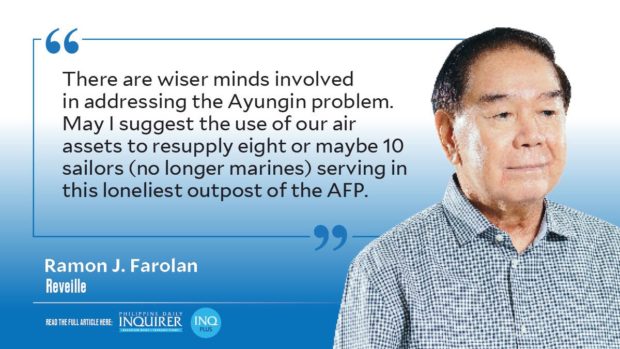Where is the Ayungin Shoal, and why all the fuss about a submerged reef in the Spratlys?
Ayungin Shoal also known as Second Thomas Shoal, is one of several in the Kalayaan Island Group located in the West Philippine Sea. It lies some 105 nautical miles west of Palawan and is well within the exclusive economic zone of the country. It is also quite close to Panganiban (Mischief) Reef, an atoll that China occupied and converted into a military outpost complete with air and naval facilities.
In 1999, during the Estrada administration, the Philippine Navy deliberately grounded an old, rusting landing ship tank formerly the USS Harnett County, on Ayungin Shoal and stationed a small detachment of Marines on the vessel that was re-christened BRP Sierra Madre. In one of my earlier columns I referred to this detachment as “the loneliest outpost in the Armed Forces.” Consider this: the BRP Sierra Madre had gaping holes in the hull and the deck with rust creeping all over the place, and not a soul in sight for miles and endless nautical miles. In summertime, one experienced scorching heat and during the monsoon season, more water than one can imagine. The reason for maintaining an outpost in the Ayungin under such difficult conditions was to assert Philippine sovereignty in the ongoing dispute with China over the Spratlys. In an article by Jeff Himmelman for The New York Times Magazine, he wrote: “Of all places, the scorched shell of the Sierra Madre has become an unlikely battleground in a geopolitical struggle that will shape the future of the South China Sea and, to some extent, the rest of the world.”
For many years, there were generally no serious problems in resupplying the lonely detachment. This is not to say that we were not bothered by Chinese intrusions. From time to time, they would make it difficult for our resupply efforts but the lifeline remained open.
Last Tuesday, Nov. 16, Philippine resupply boats loaded with supplies and provisions for the detachment were blocked by three Chinese Coast Guard vessels that water-cannoned them. No one was hurt in the incident but the mission was aborted. A Chinese foreign ministry spokesperson said that our boats trespassed into Chinese waters without their consent. Diplomatic protests were filed. Don’t hold your breath. No definite date has been set for another resupply effort. Well, for obvious reasons, no date has been announced.
The Ayungin Shoal problem falls squarely on the lap of Wescom (Western Command), one of several unified commands of the Armed Forces of the Philippines (AFP). Its headquarters is located at Camp General Artemio Ricarte in Puerto Princesa City, Palawan. The Command is headed by a veteran seadog, Vice Admiral Ramil Enriquez, who is on his fifth tour of duty in the area, and knows his way around. Incidentally, he belongs to PMA Class of 1988, the class that today controls all the security forces of the nation, military and police, including the AFP chief of staff; the chief, PNP; and the service commanders, the commanding generals Army and Air Force, and the flag officer in-command Navy. The AFP chief of staff, Gen. Andres Centino, is concurrently CG, Philippine Army, as no one has been appointed to replace him in this position.
While attention is currently focused on the Ayungin Shoal issue, Admiral Enriquez sees a long-term problem with the environmental degradation in the area caused by Chinese vessels particularly Coast Guard militia types, dumping waste of all kinds including plastic material. Perhaps, this subject should be included in Asean ministerial meetings where China is a dialogue partner. Strictly speaking, it is not just a national or regional concern but one affecting the whole world.
As to our problem at Ayungin Shoal, Wescom might consider another method of resupply to avoid water-cannoning by Chinese militia vessels. In June 1948, the Soviet Union blocked all rail, road, and canal access to Berlin sectors under Allied control. In response, the Allies organized the Berlin Airlift to resupply the people of West Berlin. US and British air forces delivered 2.3 million tons of food and supplies (mainly coal) with one plane flying into West Berlin every 30 seconds. After a year, the Soviets lifted the blockage.
There are wiser minds involved in addressing the Ayungin problem. May I suggest the use of our air assets to resupply eight or maybe 10 sailors (no longer marines) serving in this loneliest outpost of the AFP.


